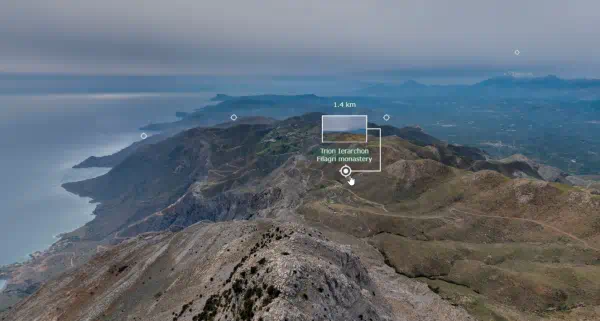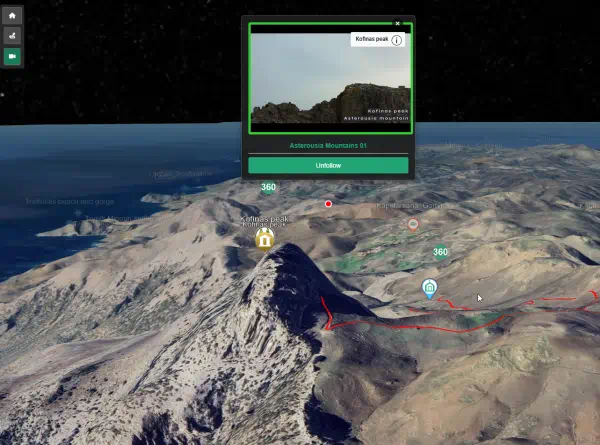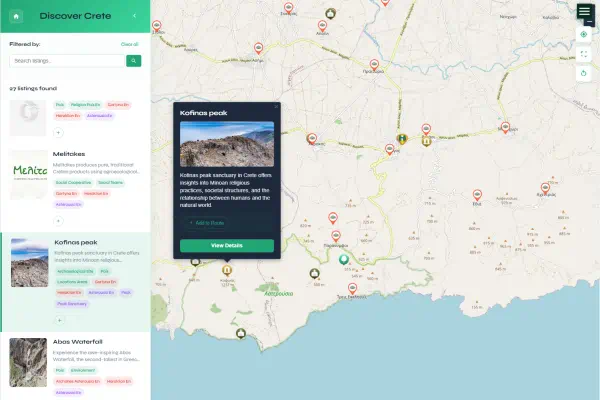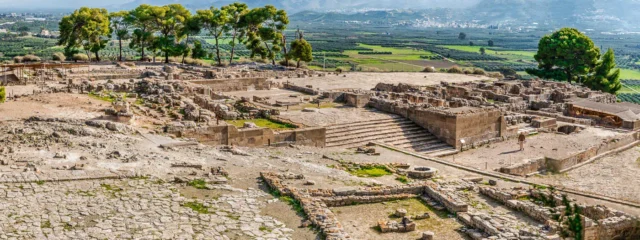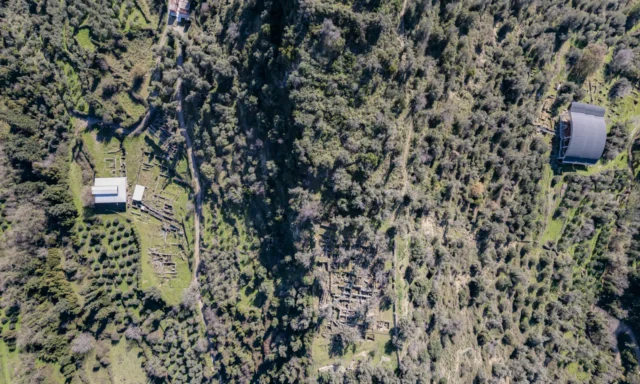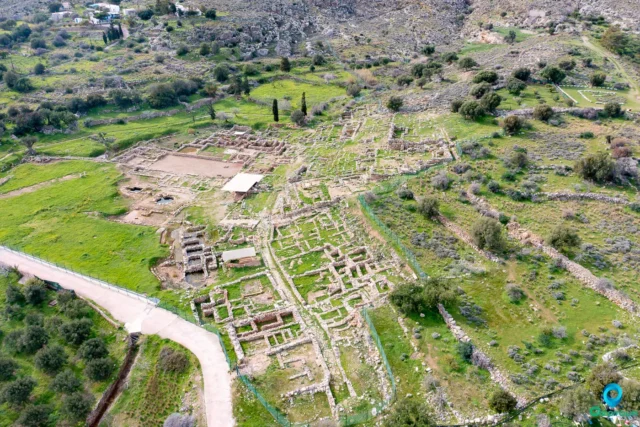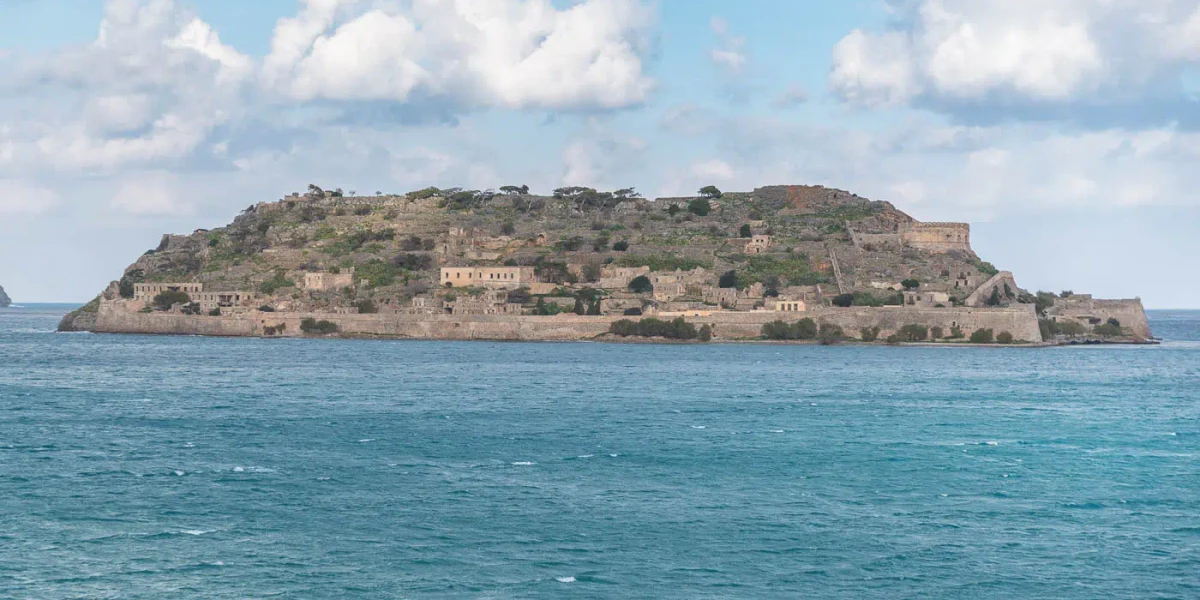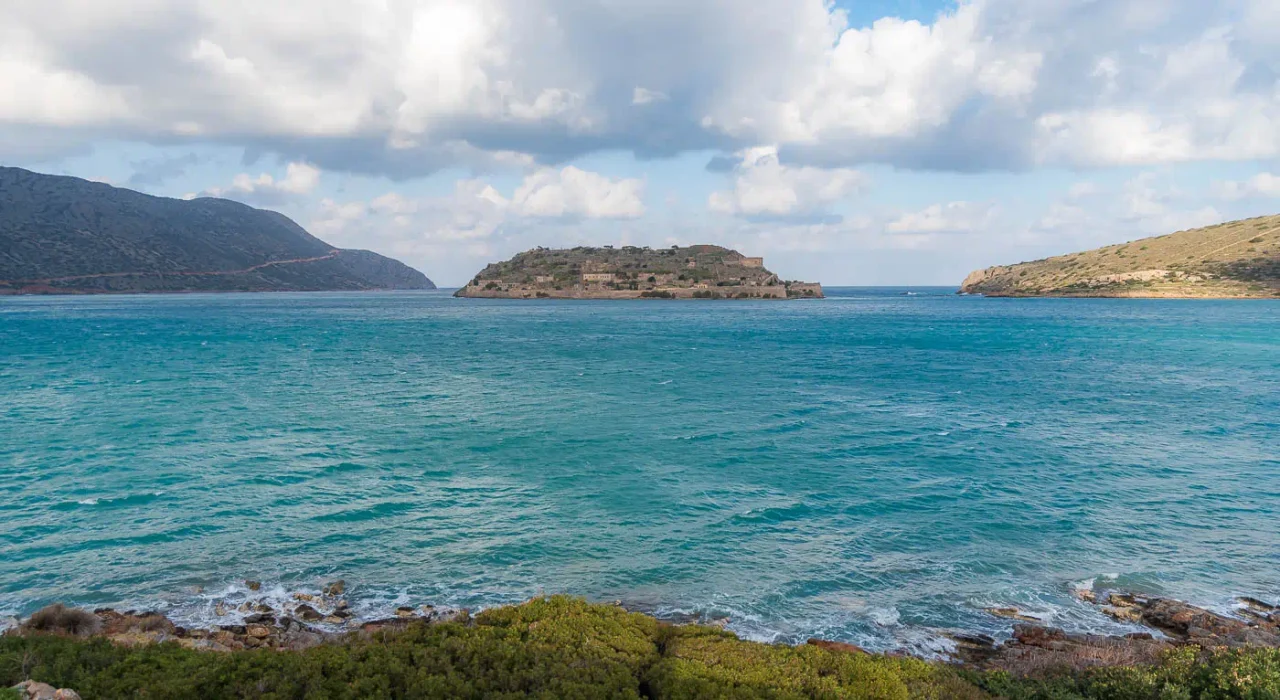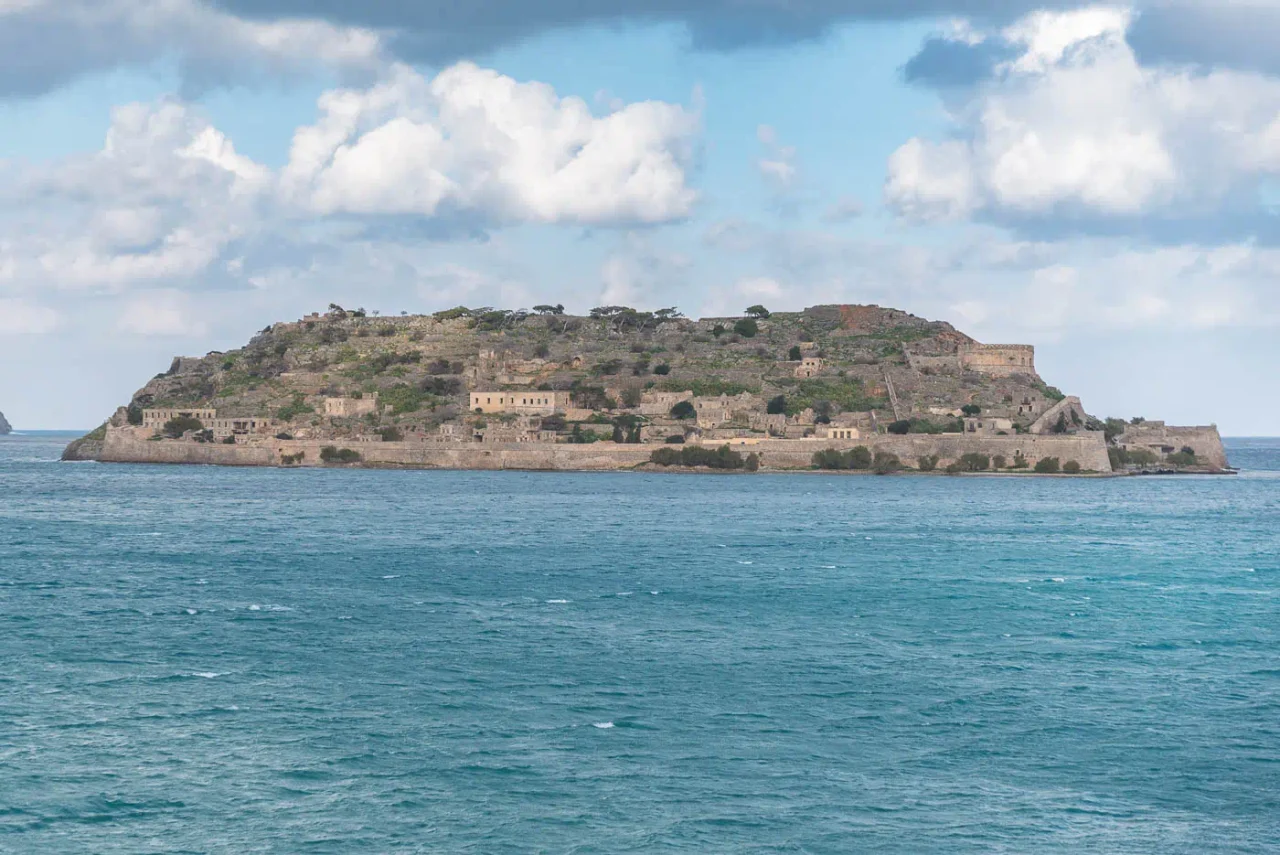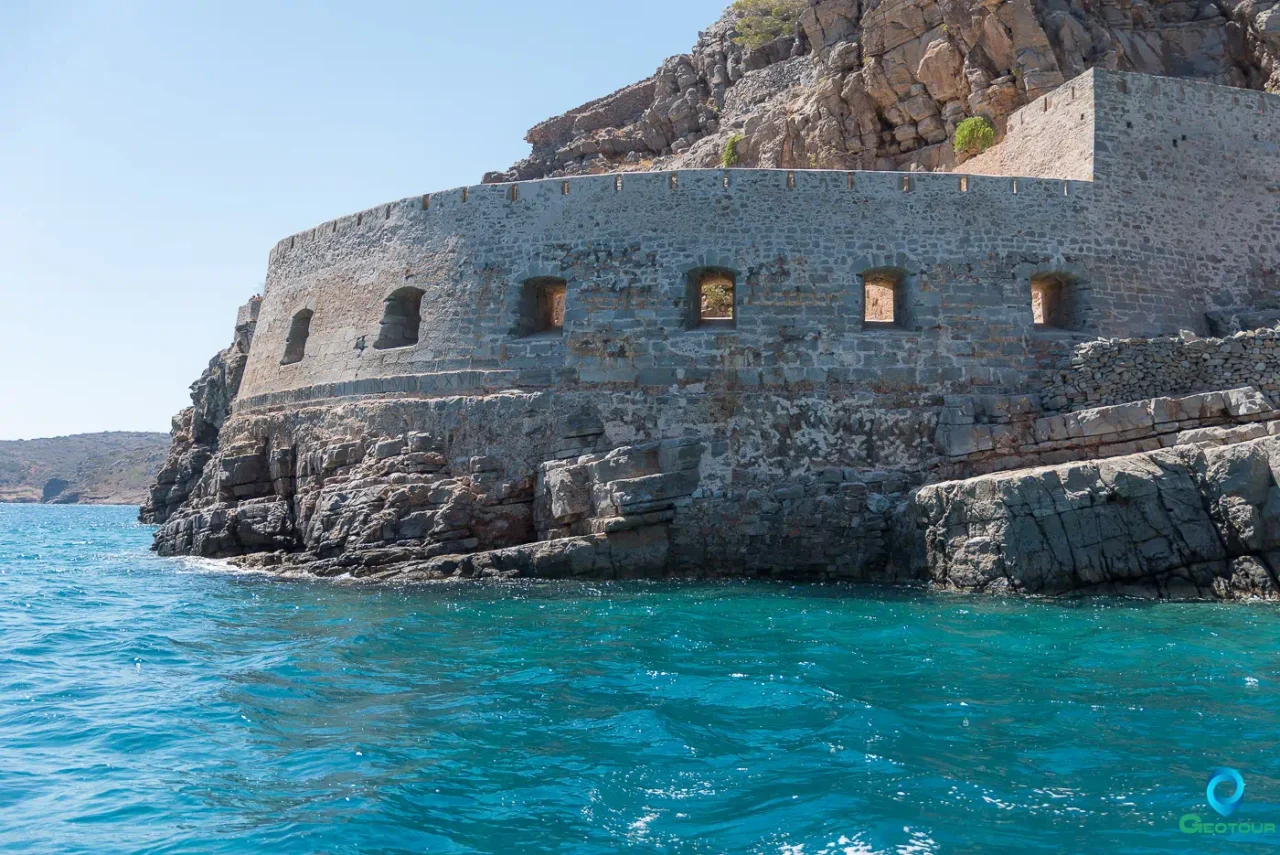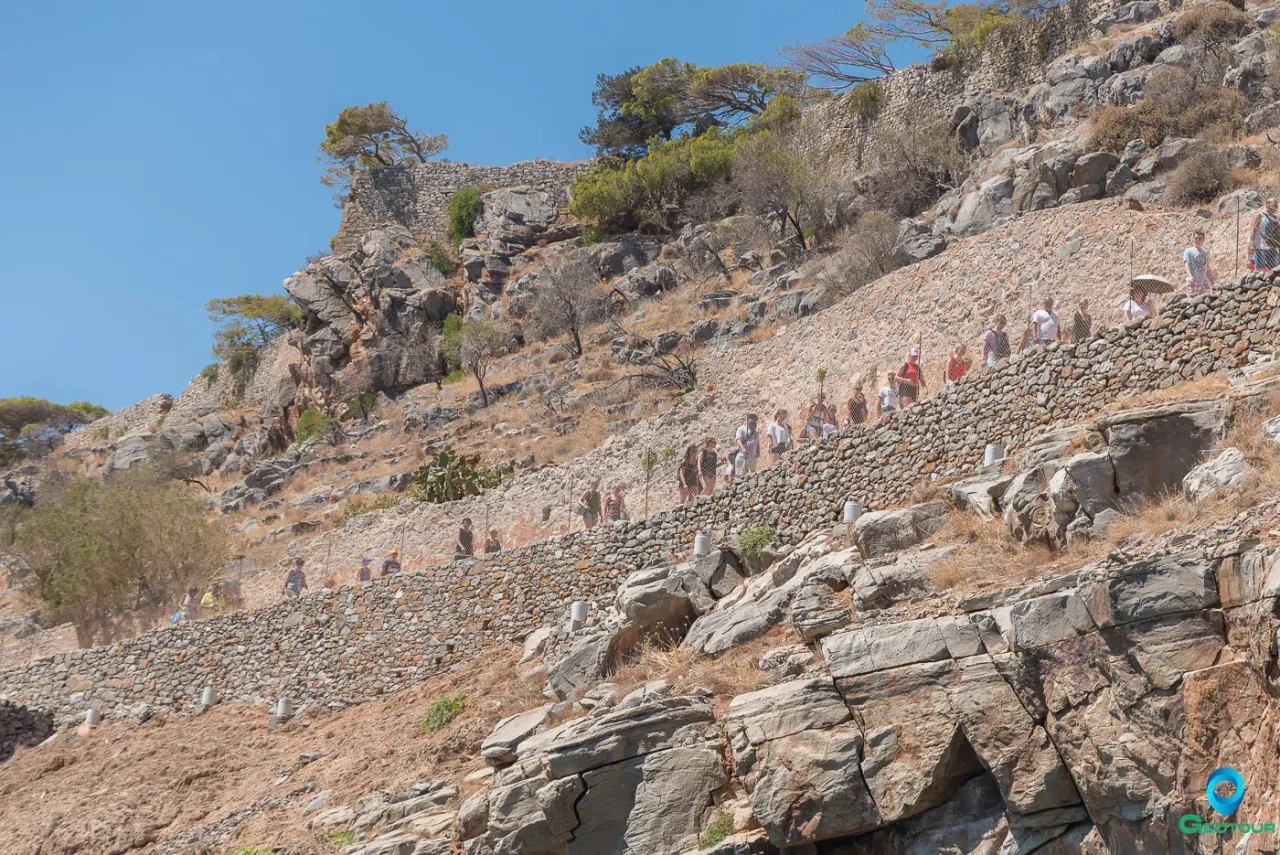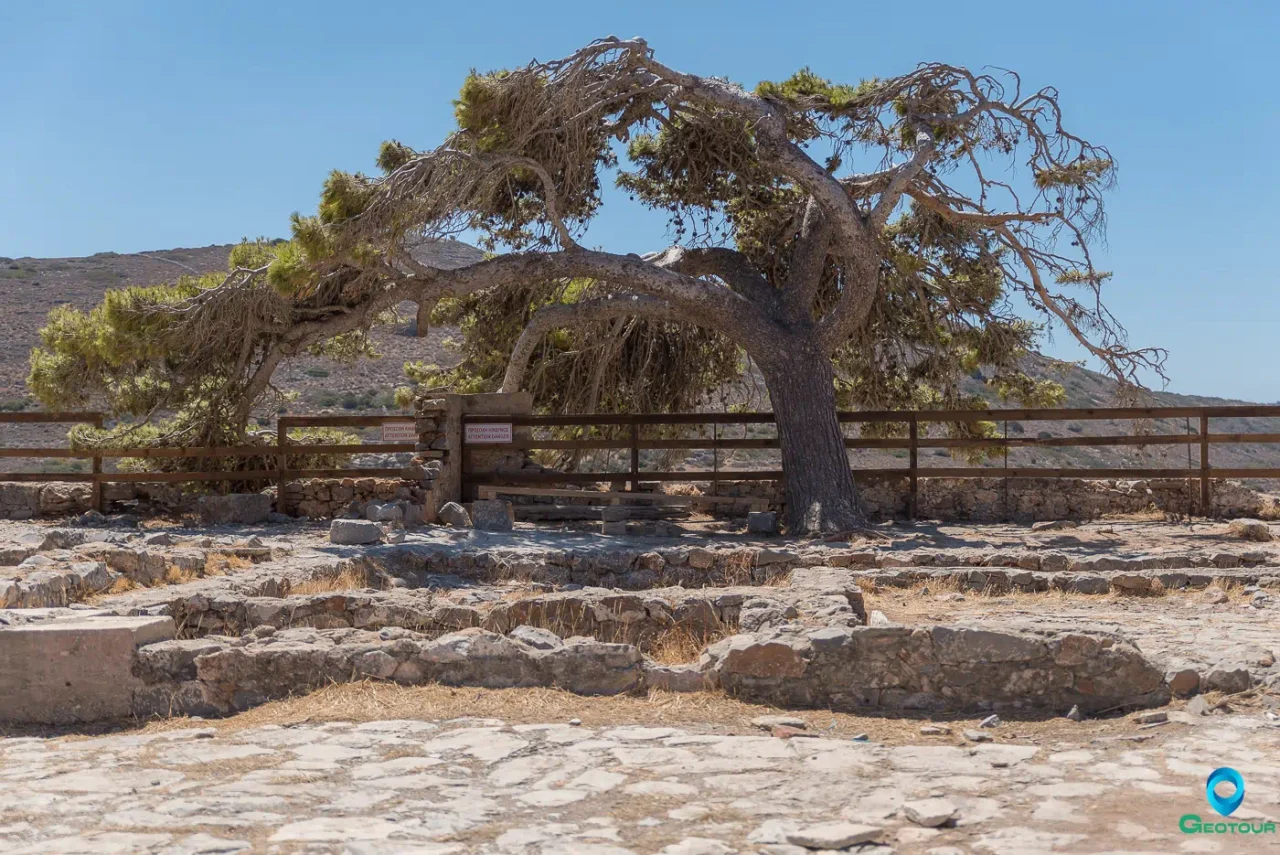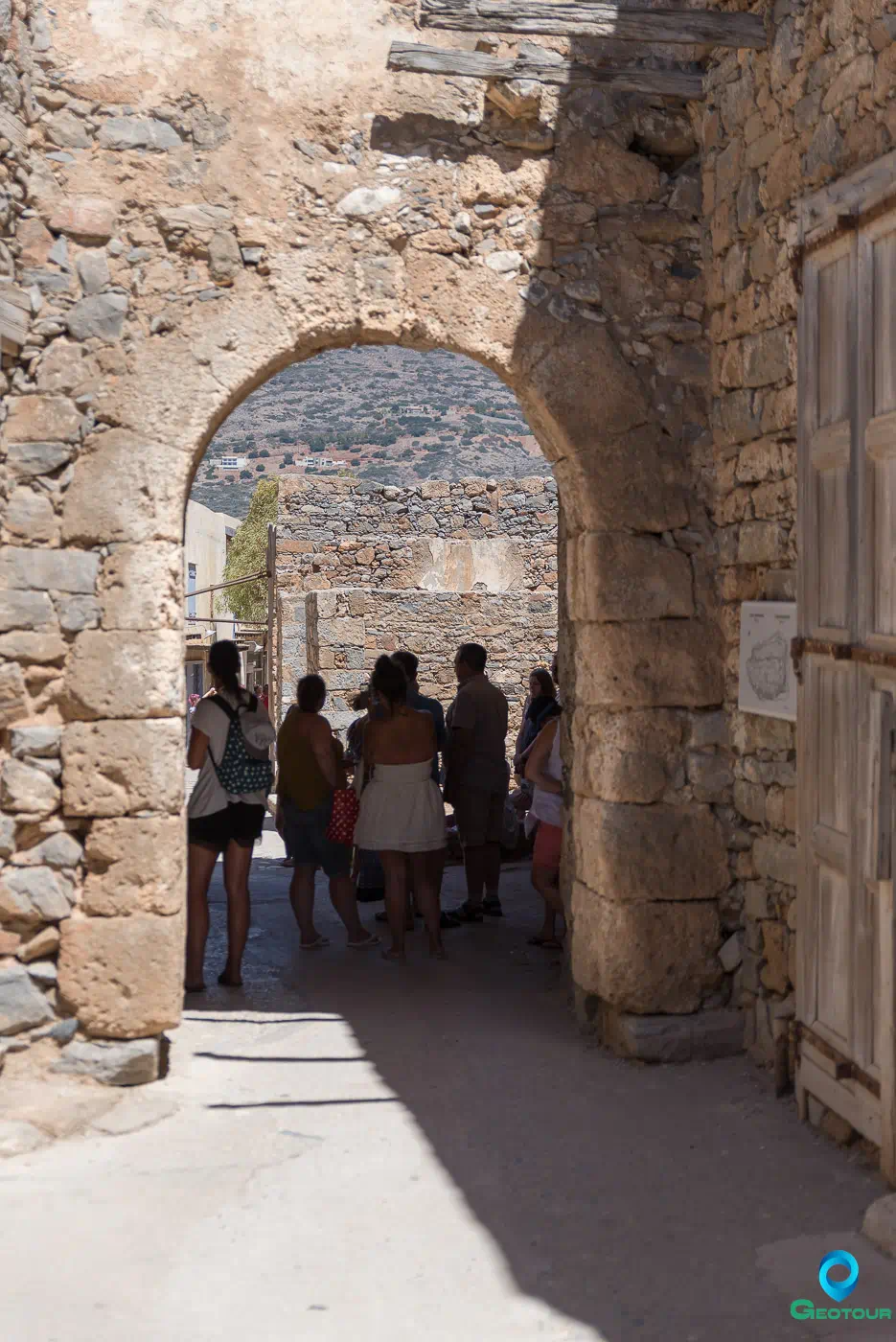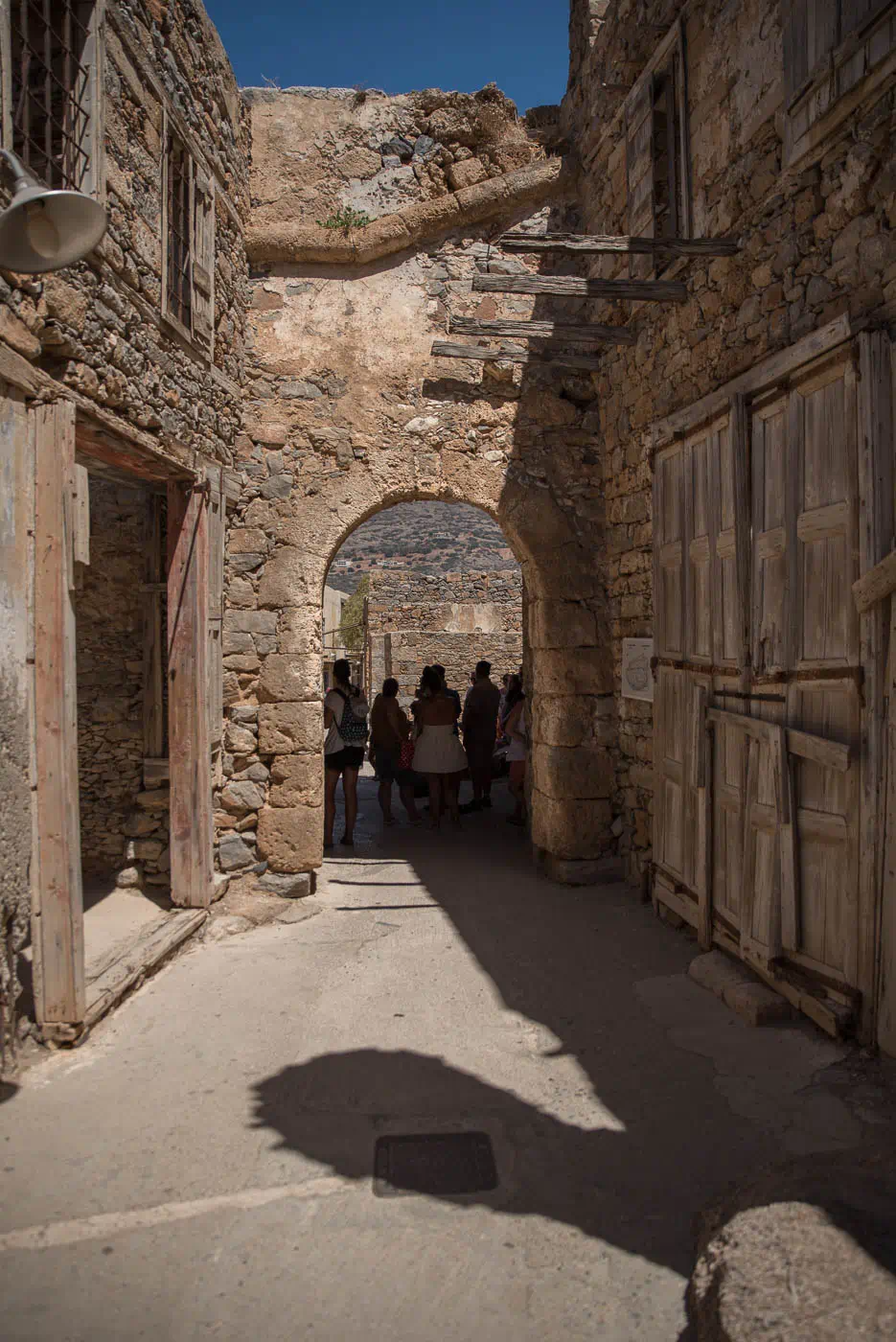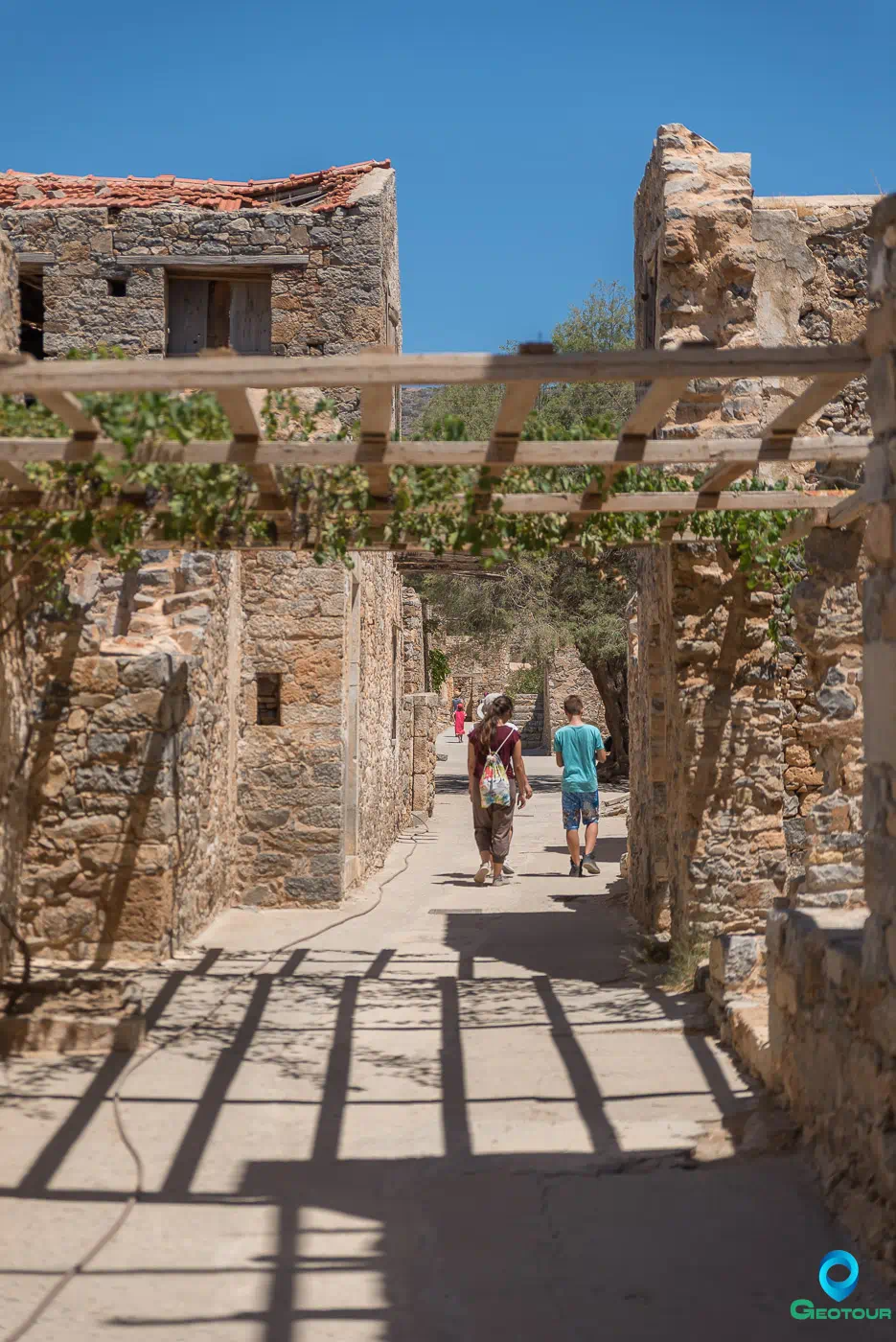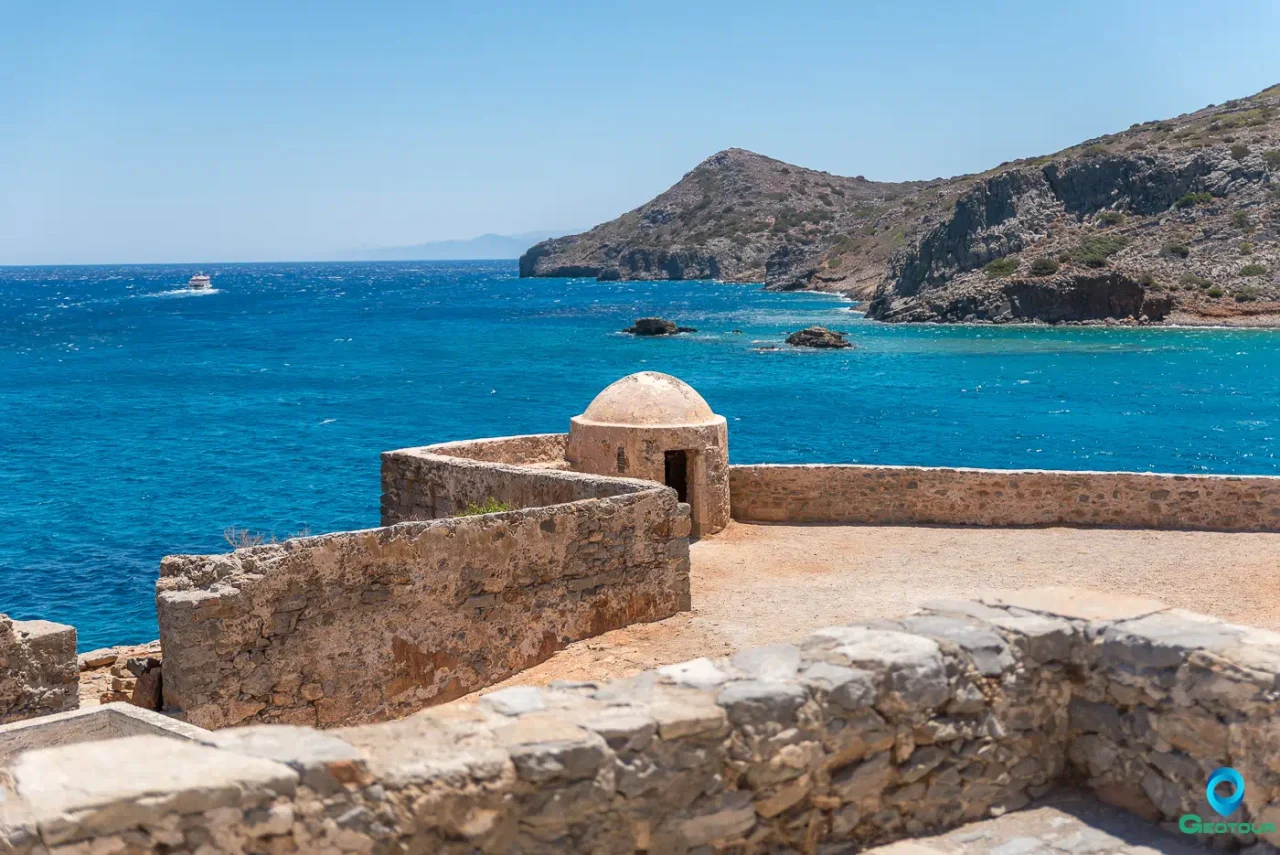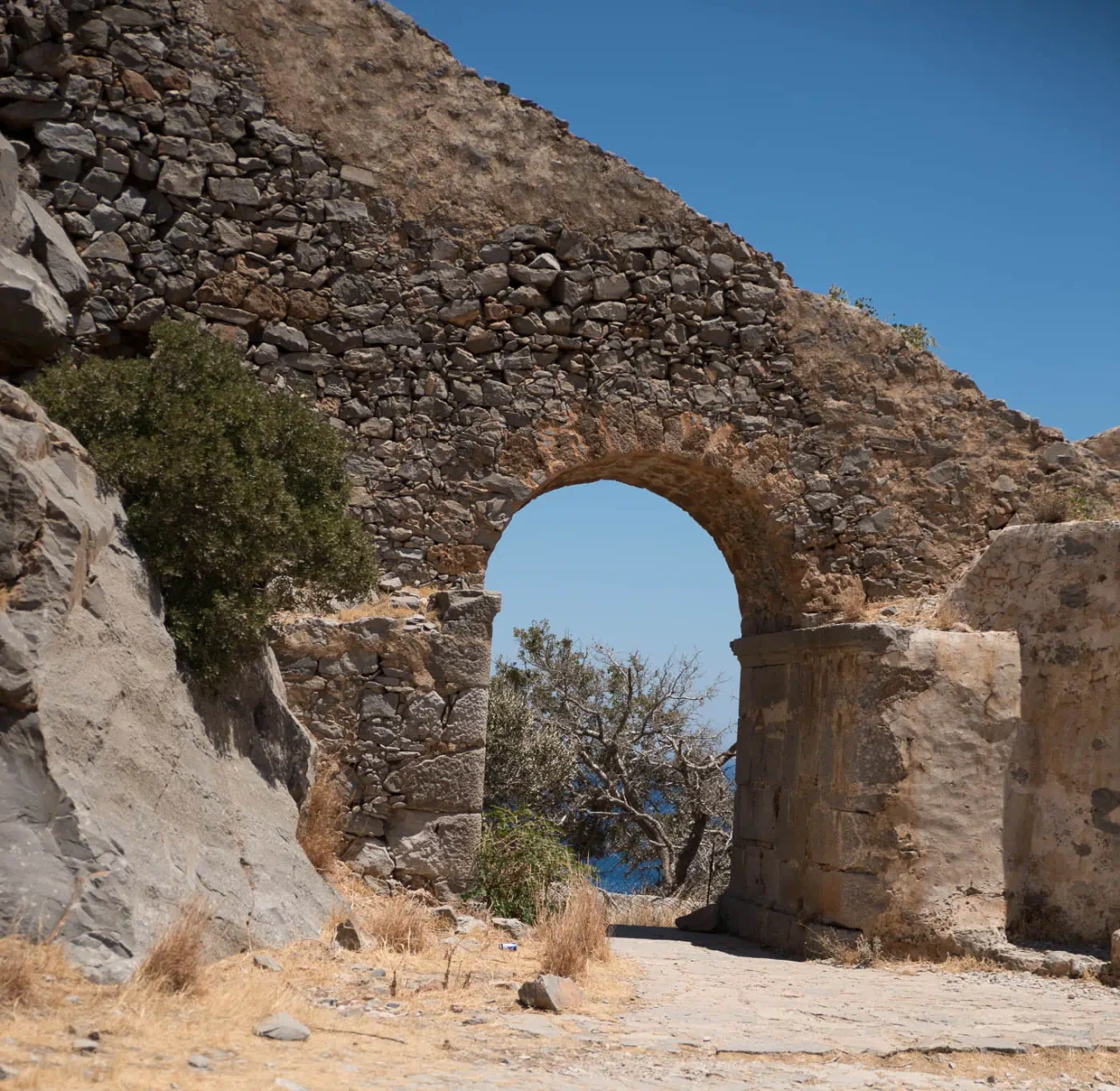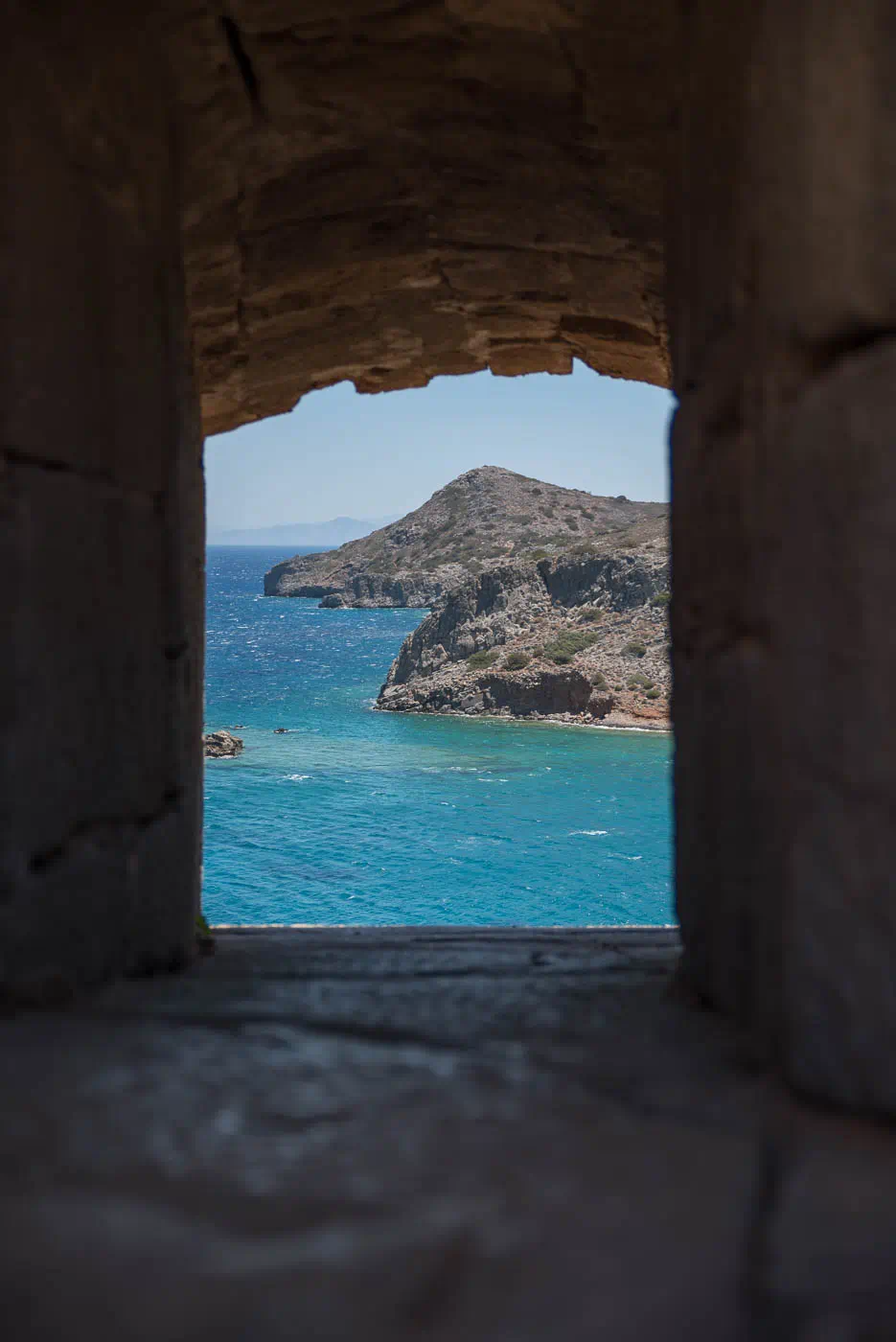Introduction: The Rock in the Gulf of Mirabello
In the Gulf of Elounda, off the northeastern coast of Crete in the regional unit of Lasithi, lies the small, arid, rocky islet of Spinalonga. Covering an area of approximately 85,000 square meters (8.5 hectares or 21 acres), the island has borne witness to centuries of human history, its landscape a palimpsest inscribed with the legacies of empires, the struggles of exiles, and the enduring power of human resilience. Though its official name, designated by the Greek state in 1953, is Kalydon, the Venetian name Spinalonga has prevailed in common parlance and historical record. The name itself is a historical artifact, believed to be a corruption of the Greek phrase “στην Ελούντα” (stin Elounda, meaning “to Elounda”), which Venetian sailors unfamiliar with the language adapted into the more familiar Italian spina lunga, or “long thorn”. According to the 16th-century Venetian cartographer Vincenzo Coronelli, Spinalonga was not always an island; it was once connected to the adjacent Kolokytha peninsula until 1526, when Venetian engineers carved a channel, physically separating it from the mainland to enhance its defensive capabilities.
From its origins as a defensive outpost for the ancient city of Olous and a Byzantine watchtower, it was transformed by the Republic of Venice into one of the most formidable sea fortresses in the Mediterranean. Following the Venetian decline, it became a thriving and strategically vital Ottoman commercial settlement. Its most poignant chapter began in the 20th century, when it was repurposed as a leprosarium, a place of forced exile that became an unexpected crucible for community and defiance. Today, Spinalonga has been reborn as a major archaeological site and a global symbol of cultural heritage, its complex past drawing hundreds of thousands of visitors each year. This study seeks to unravel these historical layers, synthesizing archaeological, archival, and sociological evidence to present a comprehensive narrative of the island’s diachronic journey from a strategic military asset to a profound monument of human memory.
Period/Era | Key Dates | Description |
Ancient & Byzantine Eras | c. 7th-12th c. CE | Connected to the ancient city of Olous. An “ancient wall” is constructed, now believed to be a Byzantine fortification from the 7th-8th century to defend against Arab raids. Ceramic evidence from the 7th-9th and 11th-12th centuries indicates its use as a strategic outpost or watchtower. |
Venetian Rule | 1210–1715 | Venetians begin developing salt pans in the Elounda bay (mid-15th c.). The island is separated from the mainland peninsula in 1526. The main fortress construction takes place from 1574 to 1586, creating a major sea bastion. During the Cretan War (1645–1669), it becomes a refuge for Christian rebels and refugees. It is the last Venetian stronghold in Crete to fall, surrendering to the Ottomans in 1715. |
Ottoman Rule | 1715–1903 | A military garrison and a permanent settlement for Muslim families are established. The island flourishes, becoming the largest Muslim commercial center in the Mirabello region by the late 19th century, with a population over 1,100. It serves as a refuge for Ottoman families during Cretan revolts (1866, 1878). The last Turkish inhabitants are compelled to leave in 1903 with the establishment of the leper colony. |
Leper Colony | 1903–1957 | The Cretan State establishes the leprosarium on May 30, 1903. The first 251 patients arrive in October 1904. After Crete’s union with Greece in 1913, patients arrive from all over the country. The “Brotherhood of Patients of Spinalonga” is founded in 1936, leading to significant improvements in living conditions. The first effective antibiotic treatments arrive in 1948. The leprosarium officially closes in 1957. |
Modern Era | 1957–Present | The last inhabitant, a priest, departs in 1962. The island is abandoned and subjected to looting, particularly during the 1960s-70s. It is declared a protected archaeological site in 1976. Major restoration projects commence (1997-2005, 2011-2013, ongoing). Greece submits the site to UNESCO’s Tentative List for World Heritage status in 2014. It becomes Crete’s second most-visited archaeological site, its popularity boosted by Victoria Hislop’s 2005 novel The Island. |
Early Foundations: From Ancient Olous to the Byzantine Watch
The strategic importance of Spinalonga is not a Venetian invention but a geographical imperative recognized since antiquity. Its origins are intrinsically linked to the ancient city of Olous, a powerful Dorian city-state located across the water in what is now the modern town of Elounda. Olous flourished from the Minoan era through the Hellenistic and Roman periods, boasting a population of over 30,000, its own democratic system, and a significant harbor that connected it to the wider Mediterranean. Although much of Olous now lies submerged, archaeological findings and ancient inscriptions attest to its regional prominence. Spinalonga’s natural position, guarding the northern entrance to this vital harbor, made it an essential component of the city’s defensive network.
While early Venetian accounts from the 16th century mention the presence of an “ancient wall” on the islet, its precise origins were long debated. Initially attributed to the Classical or Hellenistic periods as part of Olous’s defenses, recent archaeological research has compellingly re-dated this structure to the Early Byzantine period, specifically the 7th or 8th century CE. This re-dating places the construction in the context of the Byzantine Empire’s struggle against Arab maritime raids, which plagued the Aegean during this era. The fortification of Spinalonga, along with the nearby acropolis of Oxa, was part of a coordinated defensive strategy to secure the natural harbor of the Gulf of Elounda from this persistent threat.
The most concrete evidence for Spinalonga’s use during the Byzantine centuries comes from the study of ceramics recovered from the island. This material evidence points to a discontinuous but definite human presence, characterized more by strategic occupation than by permanent settlement. Analysis of the pottery reveals two distinct phases of activity:
The First Byzantine Period (c. 7th–9th centuries CE)
Pottery from this era provides clear evidence of Spinalonga’s integration into Aegean maritime networks. Key finds include sherds from several types of transport vessels, or amphorae:
- “Spherical Amphorae”: Fragments of these vessels, common throughout the Aegean in the 7th and 8th centuries, have been identified. They show close analogies to examples from the Yassiada I shipwreck and finds from Gortyn and Constantinople, confirming connections to major Byzantine trade routes.
- Hayes 38 Type Amphora: A rim fragment of this 8th-century amphora type further reinforces the evidence of maritime contact during this period.
- “Ovoid Amphorae”: Upper sections of these amphorae, dated to the 8th and 9th centuries, find direct parallels with pottery from other sites in eastern Crete, such as Pseira and Priniatikos Pyrgos. This suggests Spinalonga was part of a shared “ceramic horizon” within the Mirabello Gulf, which played an active role in the circulation of goods during this transitional period.
The context of these discoveries is as significant as the artifacts themselves. A notable concentration of these amphorae was found within a well on the island. This suggests a secondary use for the vessels, likely as containers for drawing and transporting water. This functional, logistical use of pottery, focused on transport and basic needs like water collection, points away from a developed domestic settlement. Instead, it supports the hypothesis that Spinalonga served as a military or naval outpost—a watchtower or a small garrisoned station—whose inhabitants were primarily concerned with sustenance and surveillance rather than establishing a permanent community.
The Second Byzantine Period (c. 11th–12th centuries CE)
After a period of apparent inactivity in the archaeological record, ceramic evidence indicates a renewed presence on the island during the Middle Byzantine period. Finds from this era include:
- Günsenin Type Amphorae: Fragments of Günsenin Type I-IN and Type XII amphorae, dated to the 11th century, have been discovered. These vessels are associated with the Sea of Marmara region, indicating that Spinalonga was once again a node in long-distance Byzantine trade and communication networks.
- Glazed and Cooking Wares: The discovery of a fragment of glazed sgraffito ware and a piece of a cooking pot (chytrà), both dated to the latter half of the 12th century, suggests a degree of habitation, however limited.
The overall archaeological picture from the Byzantine eras establishes a crucial theme in Spinalonga’s long history: the continuity of its strategic function despite the discontinuity of permanent settlement. The island was not a place where people consistently lived, but a place that was consistently valuable to those who controlled the surrounding seas. Its role was not that of a town or village, but of a sentinel. The Venetians did not discover its strategic importance; they recognized it, inherited it, and ultimately amplified it on a scale previously unseen.
The Venetian Fortress: Bastion of the Serenissima (1574–1715)
The transformation of Spinalonga into one of the most formidable sea fortresses in the Mediterranean was a direct consequence of the shifting geopolitical landscape of the 16th century. The fall of Cyprus to the Ottoman Empire in 1571 sent shockwaves through the Venetian Republic, exposing the vulnerability of its maritime empire (Stato da Màr). In response, Venice embarked on a massive program to fortify its remaining overseas territories, with Crete (Regno di Candia) as the centerpiece of its defense strategy. Spinalonga’s location was deemed critical for protecting the commercially valuable salt pans in the Gulf of Elounda and for securing the vital Venetian trade routes against the dual threats of Ottoman expansion and raids by Barbary corsairs.
Design and Construction: A Masterpiece of Military Engineering
The fortification of Spinalonga was a state-of-the-art project, reflecting the pinnacle of Renaissance military architecture. The process unfolded in two distinct phases, showcasing a sophisticated adaptation to both technology and terrain:
- Phase One (1579–1584): Following initial surveys in 1574, the project was entrusted to the engineer Genese Bressani in 1578. The foundation stone was laid on July 15, 1579, by Luca Michiel, the General Proveditor of Crete. Bressani’s design implemented the innovative fronte bastionato (bastion front system), creating a low-lying ring of fortifications and blockhouses along the coastline designed to repel a seaborne assault.
- Phase Two (1584–1586): In 1584, the experienced military commander Latino Orsini inspected the works and identified a critical flaw: the coastal defenses were vulnerable to artillery fire from the hills of the mainland and the adjacent Kolokytha peninsula. He proposed a second, higher line of defense along the island’s rocky ridge. This new construction, which began in 1585, gave the fortress superior artillery range and created a formidable, multi-layered defensive system that was exceptionally well-suited to the island’s challenging topography.
The architectural evolution of the fortress serves as a microcosm of Venetian military strategy. The initial, technologically advanced design by Bressani demonstrated Venice’s confidence and engineering prowess. However, the swift and pragmatic adaptation proposed by Orsini reveals a deeper understanding of the specific tactical challenges of the location. This was not the imposition of a generic template but a dynamic process of military dialogue with the landscape, reflecting the sophistication of Venetian defensive theory.
The Cretan War and the Fortress as Refuge (1645–1715)
During the long and devastating Cretan War (1645–1669), the Ottomans gradually conquered the island of Crete. After the fall of the capital, Candia (modern Heraklion), in 1669, a treaty allowed Venice to retain control of three key island fortresses: Gramvousa, Souda, and Spinalonga. For nearly half a century, these fortresses served as the last vestiges of Venetian power in the Aegean.
During this period, Spinalonga’s function underwent a profound transformation. No longer just a military outpost, it became a crucial sanctuary for Christian Cretan refugees and rebels, known as Chainides, who fled Ottoman rule. The influx of a civilian population altered the purely military character of the fortress, turning it into a densely populated, fortified settlement. The construction of five new churches during this time, in addition to the two existing Venetian chapels, attests to the establishment of a significant civilian community within the walls. This role as a haven reflects the broader decline of Venetian power; the fortress, once a tool for projecting imperial dominance, was now a defensive bastion protecting the remnants of its colonial subjects.
This final chapter of Venetian rule lasted until 1715, during the last Ottoman-Venetian War. After a three-month siege, the fortress finally surrendered. The Venetian garrison was allowed to depart, but the remaining 600 local inhabitants were taken captive, marking the definitive end of the Venetian presence in Crete.
The Ottoman Era: A Fortified Commercial Settlement (1715–1903)
With the Ottoman capture of Spinalonga in 1715, the island entered a new phase, transforming from a Venetian military outpost into a vibrant, fortified Muslim settlement that would become a key economic and administrative center in the region for nearly two centuries.
Military and Administrative Structure
Immediately upon its conquest, Spinalonga was integrated into the Ottoman administrative system. It was designated as one of the nine garrisoned fortresses of Crete and placed under the jurisdiction of the sancak (district) of Handakas (Heraklion). Unlike the major administrative centers, which were garrisoned by elite Imperial Janissaries, Spinalonga was manned exclusively by yerlü neferat, or local corps, a common practice for smaller fortresses.
The garrison was a well-organized and specialized force, typically numbering between 294 and 347 registered soldiers and officials until the early 19th century. These men lived on the island with their families, holding their positions for life, which ensured a permanent, stable community. The force was divided into five distinct corps, each with specific duties that highlight the comprehensive military capabilities of the fortress.
Ottoman Military Corps on Spinalonga | Personnel (Approx. Range, 1742-1819) | Primary Functions and Responsibilities |
Mustahfızan (Dizdarlıyan) | 103–108 | The primary fortress guard under the command of the dizdar (fortress commander). Responsible for internal security, managing the public granaries (cah), and performing minor repairs and construction with its integrated unit of artisans. |
Azaban | 86–89 | A corps with maritime duties, likely serving as port guards and crews for patrol boats securing the harbor and surrounding waters. |
Cebeciyan (Cebecis) | 26–30 | The armorers. Responsible for the maintenance, storage, and distribution of weapons and military equipment from the island’s armory (cebehane). |
Topçıyan (Topçus) | 58–60 | The artillerymen. Tasked with operating the fortress’s numerous cannons and managing the on-site cannon foundry (tophane) for repairs and maintenance. |
Humbaracıyan (Humbaracıs) | 11 | The bombardiers. A specialized unit responsible for the construction and use of mortars (havan) and grenades (humbara). |
This military structure was not merely a defensive force but the very backbone of the island’s society. The security provided by the well-manned fortress created a safe haven for maritime commerce in a region still threatened by piracy. This security, in turn, fueled a thriving economy that directly sustained the garrison community.
Economy and Society: A Symbiotic Hub of Commerce
While the soldiers were salaried state employees, their pay from the central treasury was often delayed or subject to corruption. This unreliability incentivized the garrison community to develop its own economic enterprises. A symbiotic relationship emerged: the military provided the security that made trade possible, and the profits from trade provided the economic stability that the state could not always guarantee.
By the late 19th century, this model had transformed Spinalonga into the largest and most prosperous Muslim commercial center in the entire Mirabello region, with a population reaching 1,112 inhabitants by 1881. The island’s economy was diverse and dynamic:
- Maritime Trade: The inhabitants were deeply involved in maritime commerce, acting as merchants, sailors, and shipowners. Their trade networks extended throughout the Aegean, connecting Crete with the Cyclades, the Dodecanese, and beyond. The harbor was a key stop for ships, particularly those from Kasos, which used the protected bay as a winter anchorage.
- Control of Local Resources: The island’s commander, the beg, was granted the revenues from the highly profitable salt pans of Elounda as his payment, directly linking the military leadership to the region’s most valuable commodity. The island also served as an export hub for local agricultural products, including olive oil, almonds, and carob beans.
- A Thriving Settlement: The prosperity was reflected in the settlement itself. The island was densely populated with well-built, two-story houses in a style influenced by Balkan and Anatolian architecture, complete with private courtyards and rainwater cisterns. The society had distinctly urban characteristics, boasting a high literacy rate (notably among women), a preschool, and, by 1881, a secondary school. Archaeological finds from this period include a variety of imported ceramics and numerous terracotta tobacco pipes, attesting to a comfortable and connected lifestyle.
A Place of Exile and a Final Refuge
Alongside its military and commercial functions, the fortress continued its role as a place of confinement. The Ottomans used Spinalonga as a prison for criminals and a place of exile for political undesirables from across Crete.
In the 19th century, as Christian revolutionary movements gained momentum on the mainland, the island’s role shifted once more. Its impregnable fortifications made it the ultimate safe haven for Muslim families fleeing Christian reprisals, particularly after the revolts of 1866 and 1878. This influx of refugees further solidified its status as a bastion of Ottoman identity in an increasingly hostile landscape. This role continued until 1903, when the establishment of the leper colony by the newly autonomous Cretan State compelled the last of the island’s Turkish inhabitants to depart, ending nearly two centuries of Ottoman presence.
IV. The Colony: An Island of Exile and Community (1903–1957)
The 20th century marked the most poignant and internationally renowned chapter in Spinalonga’s history. On May 30, 1903, the autonomous Cretan State passed a law to establish a leper colony on the island, a decision driven by the widespread fear and social stigma surrounding Hansen’s disease, then an incurable and disfiguring illness. This act served a dual purpose: it provided a means of isolating patients from the “healthy” population, and it was a politically expedient way to compel the last remaining Ottoman families to abandon the fortress, thereby consolidating Cretan control over the territory. In October 1904, the first 251 patients were forcibly transported to the island, beginning a 54-year period of exile and isolation.
The Formation of an “Island Community”
The initial conditions on Spinalonga were horrific. Patients were stripped of their political rights, their property was confiscated, and their marriages were annulled. Socially and legally, they were declared dead; their names were erased from their hometown registries. They were left to inhabit the decaying houses of the former Ottoman settlement with minimal state support, rudimentary medical care, and no hope of return. The main gate through which they entered became known colloquially as “Dante’s Gate,” a threshold to a life of exile from which there was no escape.
From this state of profound abjection, however, a remarkable social phenomenon emerged. The shared experience of a dreaded disease, the intense social stigmatization, and the trauma of forced exile forged a powerful and unique community. This was not a community born of choice, but one of absolute necessity—a “spontaneous collective response to a threat to life”. Isolated individuals, torn from their families and villages, transformed into a new collective entity with a singular, potent identity: they were the residents of Spinalonga. This process represents an act of profound societal creation. Legally erased and socially dead, the patients of Spinalonga did not merely endure; they constructed a new polis from scratch, an act of existential defiance against a world that had cast them out.
Life Within the Walls: The Creation of a Society
Instead of succumbing to despair, the inhabitants actively organized to recreate a functioning society within the fortress walls. They established their own internal economy and social structure, demonstrating extraordinary resilience and a deep-seated will to live with dignity.
- Self-Sufficiency and Commerce: Patients cultivated small plots of land, fished, and opened their own businesses, including cafes, a barber shop, and grocery stores, creating a semblance of normal life. A small market was established outside the main gate where goods from the mainland could be purchased, with money being sterilized to prevent the perceived spread of contagion.
- The Brotherhood of Patients: A pivotal moment in the colony’s history came in the 1930s with the arrival of more educated patients. In 1936, Epaminondas Remoundakis, a young law student who had contracted the disease, founded the “Fraternity of the Patients of Spinalonga” (Adelfotita Asθενon Spinalongas). This organization was not merely a charity but a political body that actively lobbied the Greek government, demanding better living conditions, access to new treatments, and basic human rights.
- A Cultural Renaissance: The efforts of the Brotherhood brought about a dramatic improvement in the quality of life on the island. Houses were whitewashed and repaired, a ring road was constructed around the island (a project that involved dynamiting sections of the Venetian sea walls), and an electric generator was installed to light the streets at night. Most remarkably, a cultural life flourished: a theatre and a cinema were established, showing films weekly, and classical music was played through loudspeakers in the streets. These developments were not just about improving material comfort; they were about reclaiming humanity and creating a society with culture, art, and social connection.
- Family, Faith, and Daily Life: Despite the circumstances, life continued. People fell in love and married, with over 170 marriages recorded on the island. Children were born, though healthy newborns were typically taken from their parents and sent to orphanages on the mainland to prevent infection. The community was served by a brave priest who, though not ill himself, volunteered to live among them, providing spiritual solace in the Church of St. Panteleimon.
The End of the Colony
The medical approach to leprosy evolved slowly. An early experimental treatment involved injections of chaulmoogra oil, and in 1920, the Greek prime minister Eleftherios Venizelos personally funded a doctor’s trip to India to study its application. The true turning point, however, came in 1948 with the arrival of the first modern antibiotic drugs, such as dapsone and promin, which offered an effective cure for the disease.
With a cure available, the population of the colony began to decline as patients were treated and allowed to leave. The leprosarium officially closed in 1957, and the last remaining patients were transferred to the Agia Varvara Anti-Leprosy Station in Athens. The very last inhabitant of Spinalonga was the community’s priest, who remained until 1962 to continue holding memorial services for the deceased, honoring a tradition of remembering the dead for five years after their passing.
The physical legacy of this era remains etched into the island’s landscape. The cemetery for the patients was established within the Venetian-era Donato bastion. Today, approximately 60 graves are still visible, constructed in two distinct styles: older, elevated stone structures and newer, ground-level concrete tombs covered with slabs. A small house-like ossuary also stands within the bastion, a final, silent testament to the thousands of lives that ended in this place of exile.
Modern Spinalonga: A Monument of Difficult Heritage (1957–Present)
Following the departure of its last resident in 1962, Spinalonga entered a period of silence and neglect. For nearly two decades, the island was abandoned, its buildings left to decay. During the Greek military junta (1967–1974), it suffered severe looting, with architectural elements, furniture, and building materials systematically stripped from the historic houses and repurposed for the construction of new tourist hotels on the coast of Elounda.
The tide began to turn in 1976 when the Hellenic Ministry of Culture officially declared Spinalonga a protected archaeological site, placing it under state protection and halting its degradation. This designation marked the beginning of a new era focused on conservation, restoration, and the complex task of managing the island’s multifaceted and often painful legacy.
Restoration and Documentation
Since the late 1970s, Spinalonga has been the subject of extensive and ongoing restoration projects, carried out in several major phases (including 1997–2005 and 2011–2013) under the supervision of the local Ephorate of Antiquities and the Ministry of Culture. These efforts have been comprehensive, addressing all layers of the island’s history:
- Fortifications: Work has focused on stabilizing and restoring the Venetian fortification walls, repairing breaches (many of which were made during the leprosarium era to create the ring road), and reconstructing collapsed sections of the parapets and ramparts.
- Ottoman Settlement: The streets and pathways of the Ottoman settlement have been cleared of debris and overgrowth. Numerous houses and shops have been stabilized and partially restored, allowing visitors to safely explore the historic urban fabric.
- Leper Colony Structures: While many of the 20th-century additions were controversially demolished in the late 1970s in an attempt to erase the “stigma” of the leprosarium, the remaining key buildings, such as the hospital and dormitories, are now the focus of major restoration plans.
To support this work, modern documentation techniques have been employed. Architectural surveys utilize advanced technologies such as UAV (drone) flights and Structure from Motion (SfM) photogrammetry to create highly accurate, detailed 3D models of the fortifications and buildings, providing an invaluable digital record for research and conservation.
Tourism and the “Hislop Effect”
Today, Spinalonga is one of Greece’s most prominent cultural heritage sites, ranking as the second most-visited archaeological site in Crete, surpassed only by the Palace of Knossos. Its transformation into a major tourist destination, attracting over 350,000 visitors annually, is a relatively recent phenomenon, inextricably linked to the global success of Victoria Hislop’s 2005 historical novel, The Island, and the highly popular Greek television series adapted from it. This surge in popularity, often termed the “Hislop effect,” has been a double-edged sword, bringing both vital economic resources and significant managerial challenges.
Period / Event | Visitor Statistics | Notes |
Early 2000s | Approx. 291,000 (in 2001) | Significant tourism existed prior to the novel, establishing Spinalonga as a popular local attraction. |
Post-2005 | Exponential growth | The publication of The Island in 2005 and its international success dramatically increased global awareness and visitor interest. |
Post-2011 | Peak numbers reached | Following the Greek TV adaptation (2010-2011), visitor numbers surged, reaching approximately 372,000 in 2013 and peaking at 413,000 in later years. |
Present Day | 350,000–400,000+ annually | Spinalonga remains a top tourist destination, with daily visitor numbers exceeding 4,000 in the peak summer months. |
The Challenge of “Difficult Heritage”
The immense popularity driven by a fictional narrative has created a central paradox for the site’s custodians. While the revenue from tourism is essential for funding the ongoing conservation and restoration work, it is largely fueled by a popular perception of Spinalonga that often romanticizes and sensationalizes its history. This creates what has been termed the “dark matter” of Spinalonga’s heritage: an aestheticized narrative of tragedy and sorrow that can obscure the more complex and politically charged realities of its past. Tour guides, for instance, have been known to invent ahistorical details like “Dante’s Gate” to cater to visitor expectations shaped by popular media.
The challenge lies in managing this “difficult heritage” in a way that is both respectful to the memory of those who suffered and historically authentic. The emerging management strategy is to reposition Spinalonga not just as a tourist attraction but as a “site of historical memory”. This approach, drawing parallels with sites like Robben Island in South Africa, aims to use the island’s history as an educational tool to explore universal themes of social stigma, isolation, state policy, and human rights, connecting its past to contemporary social issues.
UNESCO Nomination and Future Vision
In recognition of its unique historical and cultural value, Greece placed the Fortress of Spinalonga on its tentative list for UNESCO World Heritage status in 2014. The nomination for inscription highlights the island’s outstanding universal value based on several criteria: its innovative Venetian fortification architecture, its illustration of different phases of human history, and its powerful testimony as a former leper colony—a monument to human pain and resilience.
The future vision for Spinalonga is aligned with this heritage-focused approach. Ambitious plans are underway to convert the remaining buildings of the leprosarium, specifically the hospital and dormitories, into modern exhibition spaces. These new museum facilities will house a permanent exhibition detailing the island’s diachronic history, with a special focus on managing its “difficult heritage” and telling the human stories of its inhabitants. A key component of these plans is ensuring the entire site is made accessible to visitors with disabilities, through the installation of ramps and elevators. This strategy represents a conscious effort to leverage the global interest generated by popular culture as a gateway to a deeper, more meaningful, and historically accurate engagement with Spinalonga’s profound legacy.
Conclusion: A Site of Outstanding Universal Value
Spinalonga’s journey through centuries of conflict, commerce, and confinement has endowed it with a historical and cultural density that is almost unparalleled. It is a place where the highest achievements of Renaissance military engineering stand alongside the humble, resilient architecture of an Ottoman commercial town, and where both serve as the silent backdrop to the profound human drama of the 20th-century leper colony. This unique convergence of tangible and intangible heritage makes Spinalonga far more than a collection of picturesque ruins; it is a living monument to the enduring complexities of Mediterranean history.
The island’s story is one of constant transformation. A strategic rock, valued for its defensive position by Byzantines, was sculpted by the Venetians into an impregnable fortress, a symbol of imperial power. Under the Ottomans, this military shell was filled with the life of a bustling commercial society, demonstrating a remarkable symbiosis between security and trade. Finally, in its most tragic and compelling chapter, it became a place of profound isolation, where a community of outcasts defied their social death by creating a vibrant, self-governing society in the face of unimaginable hardship.
As articulated in its nomination for UNESCO World Heritage status, Spinalonga’s outstanding universal value lies precisely in this rich palimpsest. It is at once a masterpiece of fortification architecture, a well-preserved example of a historical settlement, and a powerful symbol of the human struggle against disease, prejudice, and isolation. Its future as a “site of historical memory” promises to transform it from a passive tourist destination into an active center for education and reflection, inviting visitors to look beyond the romanticized tragedy and engage with the deeper lessons of its past. In this, Spinalonga stands as a testament not only to the turbulent history of Crete but to the universal themes of human suffering, resilience, and the unyielding will to create community and meaning in the most challenging of circumstances.
Related material and sources
Academic Works & Journals
- Arakadaki, M. (2001). Το φρούριο της Σπιναλόγκας (1571-1715). Συμβολή στη μελέτη των επάκτιων και νησιωτικών οχυρών της Βενετικής Δημοκρατίας, τ. Αʹ: Ιστορική ανάλυση, τ. Βʹ: Αρχιτεκτονική τεκμηρίωση. Agios Nikolaos, Crete: Prefectural Administration of Lasithi.
- Bourbou, C. (2006). The Leprosarium of Spinalonga (1903-1957) in Eastern Crete (Greece). Eres Arqueología / Bioantropología, 14, 121-138.
- Giagkaki, A. (2022). Η Σπιναλόγκα μέσα από τη μελέτη της κεραμικής: συνέχειες και ασυνέχειες. Πεπραγμένα ΙΓ΄ Διεθνούς Κρητολογικού Συνεδρίου.
- Moschovi, G. (2012). Ο οχυρωμένος οικισμός της Σπιναλόγκας. Σύγχρονες χρήσεις. In A. Kavvadia-Spondyli & P. Damoulos (Eds.), Η οχυρωματική αρχιτεκτονική στο Αιγαίο και ο μεσαιωνικός οικισμός Αναβάτου Χίου. Πρακτικά [Fortification architecture in the Aegean and the medieval settlement of Anavatos, Chios. Proceedings] (pp. 395-403). Chios.
- Spyropoulos, Y. (2013). Η Σπιναλόγκα των οθωμανικών χρόνων. Κρητικά Χρονικά, 33, 121-154.
Articles & News Sources
- Fortress of Spinalonga – UNESCO World Heritage Centre
- Byzantine Times – Hellenic Ministry of Culture
- The Daily Life in the Ottoman Settlement – Hellenic Ministry of Culture
- The Daily Life in the Leper Colony – Hellenic Ministry of Culture
- The Spinalonga blues – Archaeology Wiki
- Spinalonga Leprosy Center to Be Converted into Exhibition Space – GTP Headlines

